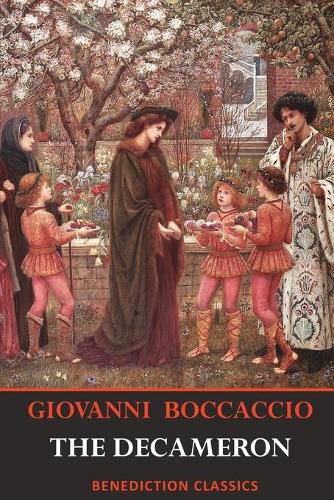Readings Newsletter
Become a Readings Member to make your shopping experience even easier.
Sign in or sign up for free!
You’re not far away from qualifying for FREE standard shipping within Australia
You’ve qualified for FREE standard shipping within Australia
The cart is loading…






This title is printed to order. This book may have been self-published. If so, we cannot guarantee the quality of the content. In the main most books will have gone through the editing process however some may not. We therefore suggest that you be aware of this before ordering this book. If in doubt check either the author or publisher’s details as we are unable to accept any returns unless they are faulty. Please contact us if you have any questions.
Giovanni Boccaccio’s work taught citizens how to maintain mental wellbeing in times of epidemics and isolation. - The New Statesman.
In 1348 the plague struck Florence with devastating fury–killing three quarters of its population. Ten young men and women fled the plague-ridden city to a deserted villa in the countryside. To pass the evenings and to remember their former lives, each member of the party told a story illustrating the set theme of the night. And so, we have these one hundred wonderfully vivid stories. These are tales of love, passion, jealousy, and pride as well as of profit and loss. Ribaldry, licentiousness, farce, trickery and deceit are a constant thread, but with a moral undercurrent. Boccaccio’s stories are miniatures which give us a window onto life at the time and depict a society on the cusp of change, with the renaissance virtues of quick-wittedness, intelligence and sophistication trumping the monastic and feudal virtues of piety and loyalty.
The Decameron is a masterpiece of early Italian prose, and its tales have inspired many subsequent writers, most famously Chaucer and Shakespeare but also Moliere, Tennyson, Keats, Longfellow and Shelley. Even Martin Luther had occasion to repurpose one of Boccaccio’s stories.
About the Author: Giovanni Boccaccio (1313 - 1375) was a medieval Italian writer and an important early humanist. Along with Petrarch and Dante, he is regarded as one of the fathers of the Italian language. In contrast to the formulaic approach of his medieval contemporaries, Boccaccio uses realistic dialogue and complex plots which were unusual at the time. His best-known work after The Decameron is On Famous Women, the first collection devoted exclusively to biographies of women in Western literature.
About the Translator: John Payne was a poet and translator, who is especially remembered for his translations of The Decameron, The Arabian Nights and the Diwan Hafez.
$9.00 standard shipping within Australia
FREE standard shipping within Australia for orders over $100.00
Express & International shipping calculated at checkout
This title is printed to order. This book may have been self-published. If so, we cannot guarantee the quality of the content. In the main most books will have gone through the editing process however some may not. We therefore suggest that you be aware of this before ordering this book. If in doubt check either the author or publisher’s details as we are unable to accept any returns unless they are faulty. Please contact us if you have any questions.
Giovanni Boccaccio’s work taught citizens how to maintain mental wellbeing in times of epidemics and isolation. - The New Statesman.
In 1348 the plague struck Florence with devastating fury–killing three quarters of its population. Ten young men and women fled the plague-ridden city to a deserted villa in the countryside. To pass the evenings and to remember their former lives, each member of the party told a story illustrating the set theme of the night. And so, we have these one hundred wonderfully vivid stories. These are tales of love, passion, jealousy, and pride as well as of profit and loss. Ribaldry, licentiousness, farce, trickery and deceit are a constant thread, but with a moral undercurrent. Boccaccio’s stories are miniatures which give us a window onto life at the time and depict a society on the cusp of change, with the renaissance virtues of quick-wittedness, intelligence and sophistication trumping the monastic and feudal virtues of piety and loyalty.
The Decameron is a masterpiece of early Italian prose, and its tales have inspired many subsequent writers, most famously Chaucer and Shakespeare but also Moliere, Tennyson, Keats, Longfellow and Shelley. Even Martin Luther had occasion to repurpose one of Boccaccio’s stories.
About the Author: Giovanni Boccaccio (1313 - 1375) was a medieval Italian writer and an important early humanist. Along with Petrarch and Dante, he is regarded as one of the fathers of the Italian language. In contrast to the formulaic approach of his medieval contemporaries, Boccaccio uses realistic dialogue and complex plots which were unusual at the time. His best-known work after The Decameron is On Famous Women, the first collection devoted exclusively to biographies of women in Western literature.
About the Translator: John Payne was a poet and translator, who is especially remembered for his translations of The Decameron, The Arabian Nights and the Diwan Hafez.